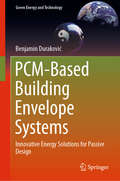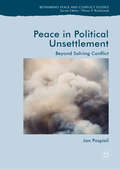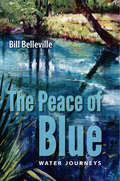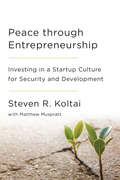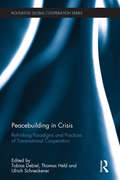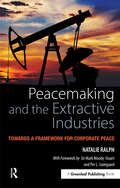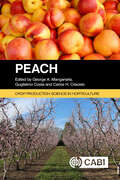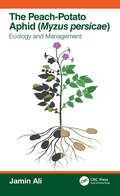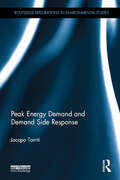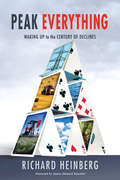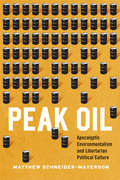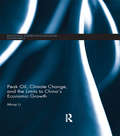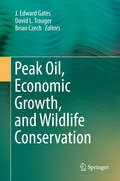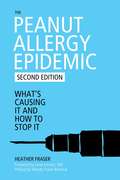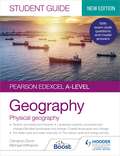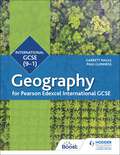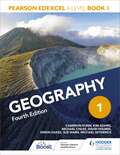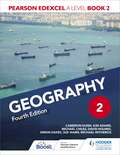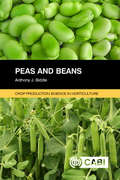- Table View
- List View
PCM-Based Building Envelope Systems: Innovative Energy Solutions for Passive Design (Green Energy and Technology)
by Benjamin DurakovićPCM Enhanced Building Envelopes presents the latest research in the field of thermal energy storage technologies that can be applied to solar heating and cooling with the aim of shifting and reducing building energy demand. It discusses both practical and technical issues, as well as the advantages of using common phase change materials (PCMs) in buildings as a more efficient, novel solution for passive solar heating/cooling strategies. The book includes qualitative and quantitative descriptions of the science, technology and practices of PCM-based building envelopes, and reflects recent trends by placing emphasis on energy storage solutions within building walls, floors, ceilings, façades, windows, and shading devices. With the aim of assessing buildings’ energy performance, the book provides advanced modeling and simulation tools as a theoretical basis for the analysis of PCM-based building envelopes in terms of heat storage and transfer. This book will be of interest to all those dealing with building energy analysis such as researchers, academics, students and professionals in the fields of mechanical and civil engineering and architectural design
Peace in Political Unsettlement: Beyond Solving Conflict (Rethinking Peace and Conflict Studies)
by Jan PospisilInternational peacebuilding has reached an impasse. Its lofty ambitions have resulted in at best middling success, punctuated by moments of outright failure. The discrediting of the term ‘liberal peacebuilding’ has seen it evolve to respond to the numerous critiques. Notions such as ‘inclusive peace’ merge the liberal paradigm with critical notions of context, and the need to refine practices to take account of ‘the local’ or ‘complexity’. However, how this would translate into clear guidance for the practice of peacebuilding is unclear. Paradoxically, contemporary peacebuilding policy has reached an unprecedented level of vagueness. Peace in political unsettlement provides an alternative response rooted in a new discourse, which aims to speak both to the experience of working in peace process settings. It maps a new understanding of peace processes as institutionalising formalised political unsettlement and points out new ways of engaging with it. The book points to the ways in which peace processes institutionalise forms of disagreement, creating ongoing processes to manage it, rather than resolve it. It suggests a modest approach of providing ‘hooks’ to future processes, maximising the use of creative non-solutions, and practices of disrelation, are discussed as pathways for pragmatic post-war transitions. It is only by understanding the nature and techniques of formalised political unsettlement that new constructive ways of engaging with it can be found.
The Peace of Blue: Water Journeys
by Bill BellevilleThe Earth’s surface is mostly oceans, the human body is approximately 60% water, and the human imagination has been captivated by this life-giving, life-sustaining liquid from time immemorial.According to Carl Hiaasen, Bill Belleville “writes gorgeously and straight from the heart. In The Peace of Blue, the documentarian and nature writer guides you on a lyrical journey to the natural places in Florida and the Caribbean that have been forged and shaped by water. He poetically underscores the vitality of this most essential substance in our lives by showing the many ways in which water-driven landscapes nurture plants, wildlife—and the human spirit.Experience the thrill of traveling to the remote islands of Cuba and to sacred cenotes in the Dominican Republic. Contemplate the shores of Florida’s rivers and lakes and marvel at swamps and seepage slopes. Immerse yourself in the underwater world of clear, fresh springs, and dive into the deep karst caves that are worlds unto themselves.Through adventure and contemplative excursions, Belleville shares his contagious respect—and awe—for the singularity and transcendence of the natural world. We are companions in his search for a distinct sense of place, fellow journeymen in his quest to discover within the watery depths a greater awareness that informs and shapes our common identity.
Peace of Mind in Earthquake Country
by Peter YanevThe geologic, architectural and structural hazards of earthquakes, and how to recognize, avoid or correct them.
Peace Through Entrepreneurship: Investing in a Startup Culture for Security and Development
by Matthew Muspratt Steven R. KoltaiJoblessness is the root cause of the global unrest threatening American security. Fostering entrepreneurship is the remedy.The combined weight of American diplomacy and military power cannot end unrest and extremism in the Middle East and other troubled regions of the world, Steven Koltai argues. Koltai says an alternative approach would work: investing in entrepreneurship and reaping the benefits of the jobs created through entrepreneurial startups.From 9/11 and the Arab Spring to the self-proclaimed Islamic caliphate, instability and terror breed where young people cannot find jobs. Koltai marshals evidence to show that joblessness-not religious or cultural conflict-is the root cause of the unrest that vexes American foreign policy and threatens international security.Drawing on Koltai's stint as senior adviser for Entrepreneurship in Secretary Hillary Clinton's State Department, and his thirty-year career as a successful entrepreneur and business executive, Peace through Entrepreneurship argues for the significant elevation of entrepreneurship in the service of foreign policy; not rural microfinance or mercantile trading but the scalable stuff of Silicon Valley and Sam Walton, generating the vast majority of new jobs in economies large and small.Peace through Entrepreneurship offers a nonmilitary, long-term solution at a time of disillusionment with Washington's "big development" approach to unstable and underdeveloped parts of the world-and when the new normal is fear of terrorist attacks against Western targets, beheadings in Syria, and jihad. Extremism will not be resolved by a war on terror. The answer, Koltai shows, is stimulating entrepreneurial economic opportunities for the virtually limitless supply of desperate, unemployed young men and women leading lives of endless economic frustration.
Peacebuilding in Crisis: Rethinking Paradigms and Practices of Transnational Cooperation (Routledge Global Cooperation Series)
by Thomas Held Tobias Debiel Ulrich SchneckenerThe 1990s saw a constant increase in international peace missions, predominantly led by the United Nations, whose mandates were more and more extended to implement societal and political transformations in post-conflict societies. However, in many cases these missions did not meet the high expectations and did not acquire a sufficient legitimacy on the local level. Written by leading experts in the field, this edited volume brings together ‘liberal’ and ‘post-liberal’ approaches to peacebuilding. Besides challenging dominant peacebuilding paradigms, the book scrutinizes how far key concepts of post-liberal peacebuilding offer sound categories and new perspectives to reframe peacebuilding research. It thus moves beyond the ‘liberal’–‘post-liberal’ divide and systematically integrates further perspectives, paving the way for a new era in peacebuilding research which is theory-guided, but also substantiated in the empirical analysis of peacebuilding practices. This book will be essential reading for postgraduate students and scholar-practitioners working in the field of peacebuilding. By embedding the subject area into different research perspectives, the book will also be relevant for scholars who come from related backgrounds, such as democracy promotion, transitional justice, statebuilding, conflict and development research and international relations in general.
Peacemaking and the Extractive Industries: Towards a Framework for Corporate Peace
by Natalie RalphPeacemaking and the Extractive Industries addresses a significant gap in research on the political and diplomatic role of multinational corporations in peace processes in intrastate conflict: Corporate Peacemaking. The author focuses on corporations in the oil and mining sectors, supporting or participating in peace negotiations and mediation. The chapters explore national-level peace processes, as well as those at community and global levels. While the focus is on extractive companies, the findings are valuable to companies from all industries looking at peace-related processes. This ground-breaking book gives a comprehensive picture of how Corporate Peacemaking currently works, how it can be developed and implemented, and how it is likely to impact global governance and corporate culture in the future. The book demonstrates that Corporate Peacemaking has the potential to be a powerful element in international governance and peace efforts; and Ralph shows through the business case that companies, as well as communities, will benefit. Ralph presents a new framework for Corporate Peace that will assist companies from all sectors in countries experiencing violent conflict, in addition to instability, human rights abuses and poor governance. Based on rigorous academic research with practical case studies, it is essential reading for practitioners, academics, policy-makers and NGOs.
Peach (Crop Production Science in Horticulture)
by Maria Luisa Badenes James Adaskaveg B. Anthony Daniele Bassi B. Blaauw C. Bonghi A. Botton M. Cirilli Luis Cisneros-Zevallos M. Christofi B. Dichio M. F. Drincovich P. Drogoudi Gemma Echeverria Helga Förster S. Foschi K. Gasic Daniela Giovannini Thomas M Gradziel I. Iglesias Gregory A Lang J. C. Melgar P. Milonas I. S. Minas B. Morandi M. Á. Moreno A. L. Nielsen Nikolaos T Papadopoulos J. Pieper G. Reig Gregory Reighard David Ritchie S. Sansavini Guido Schnabel P. Tonutti L. Trainotti A. R Vicente C. XiloyannisPeach is a highly valuable temperate fruit crop with significant consumer demand and nutraceutical benefits. This book provides comprehensive and up-to-date coverage on sustainable production processes for peach and nectarine. The latter is a natural mutation of peach that lacks fuzzy skin. It includes fundamental information to help reduce production risks for growers, improve fruit quality, and increase potential market returns, whilst addressing current emerging issues such as climate change and shifting global and regional production practices. Written by an international team of expert authors and highly illustrated in full colour throughout, Peach presents information in an organized and easy-to-follow manner, with content including: Peach tree architecture. Rootstocks. Cultivars. In-field operations (irrigation, fertilization, thinning, harvest) Fruit quality, composition and nutritional benefits. Peach fruit growth, development and ripening physiology. Postharvest technology, including supply chain management protocols. Preharvest and postharvest diseases. Biology and management of insect pests. The peach canning industry. This is an essential resource for students and researchers in horticulture, as well as professionals in pomology including fruit growers, consultants and extension specialists, and cold storage and transportation managers.
The Peach Potato Aphid (Myzus persicae): Ecology and Management
by Jamin AliConsidered as economically significant pests with worldwide distribution, aphids feed on hundreds of cultivated and ornamental plants and cause considerable economic loss on a global scale. The peach-potato aphid, Myzus persicae, is one of the most severe model aphid pests and successfully colonizes hundreds of plant species from 40 different families. It is a complex aphid pest known for its high reproductive rate, biotype formation, suppression of plant defenses, and wide range of host plants. This book covers ecological aspects - including life cycle, damage, and host range - which make aphids an economically important pest. A wide range of topics are covered, including ecological aspects of M. persicae; challenges with management approaches; damage; suppression of plant defenses; evolution; the mechanism of resistance against major classes of insecticides; the potential of biological control and natural plant-derived compounds (plant defense elicitors) as an alternative to the use of synthetic chemical insecticides to control M. persicae; and integrated pest management for M. persicae. As the peach-potato aphid is a model aphid pest, studying it helps to develop control strategies against the entire group of aphids. Written for professionals, as well as students, teachers, and researchers in the fields of entomology, ecology, and bioscience, this book is an enriching new addition to its field.
Peak Energy Demand and Demand Side Response (Routledge Explorations in Environmental Studies)
by Jacopo TorritiWith different intensities, depending on the season, every morning and evening of any weekday there are the same peaks in electricity demand. Peaks can bring about significantly negative environmental and economic impacts. Demand Side Response is a relatively recent solution in Europe which has the potential to reduce peak demand and ease impending capacity shortages. Peak Energy Demand and Demand Side Response presents evidence on a set of Demand Side Response activities, ranging from price-based to incentive-based programmes and policies. Examples are drawn from different programmes for both residential and non-residential sectors of electricity demand, including Time of Use tariffs, Critical Peak Pricing Automated Demand Controllers and Ancillary Services. The book also looks at the actual energy saving impacts of smart meters, the activities which constitute peak demand and the potential opportunities associated with European smart grids and Capacity Markets. This is the first book presenting comprehensive analysis of the impacts, cost benefits and risks associated with Demand Side Response programmes and policies. It should be of interest to students, scholars and policy-makers in the areas of energy, environmental economics and applied economics.
Peak Everything
by Richard HeinbergThe twentieth century saw unprecedented growth in population, energy consumption, and food production. As the population shifted from rural to urban, the impact of humans on the environment increased dramatically.The twenty-first century ushered in an era of declines, in a number of crucial parameters: Global oil, natural gas, and coal extraction Yearly grain harvests Climate stability Population Economic growth Fresh water Minerals and ores, such as copper and platinum To adapt to this profoundly different world, we must begin now to make radical changes to our attitudes, behaviors, and expectations. Peak Everything addresses many of the cultural, psychological, and practical changes we will have to make as nature rapidly dictates our new limits. This latest book from Richard Heinberg, author of three of the most important books on Peak Oil, touches on the most important aspects of the human condition at this unique moment in time.A combination of wry commentary and sober forecasting on subjects as diverse as farming and industrial design, this book tells how we might make the transition from the Age of Excess to the Era of Modesty with grace and satisfaction, while preserving the best of our collective achievements. A must-read for individuals, business leaders, and policymakers who are serious about effecting real change. Richard Heinberg is a journalist, lecturer, and the author of seven books, including The Party's Over, Powerdown, and The Oil Depletion Protocol. He is one of the world's foremost Peak Oil educators.
Peak Oil: Apocalyptic Environmentalism and Libertarian Political Culture
by Matthew Schneider-MayersonIn recent years, the concept of "peak oil"--the moment when global oil production peaks and a train of economic, social, and political catastrophes accompany its subsequent decline--has captured the imagination of a surprisingly large number of Americans, ordinary citizens as well as scholars, and created a quiet, yet intense underground movement. In Peak Oil, Matthew Schneider-Mayerson takes readers deep inside the world of "peakists," showing how their hopes and fears about the postcarbon future led them to prepare for the social breakdown they foresee--all of which are fervently discussed and debated via websites, online forums, videos, and novels. By exploring the worldview of peakists, and the unexpected way that the fear of peak oil and climate change transformed many members of this left-leaning group into survivalists, Schneider-Mayerson builds a larger analysis of the rise of libertarianism, the role of oil in modern life, the political impact of digital technologies, the racial and gender dynamics of post-apocalyptic fantasies, and the social organization of environmental denial.
Peak Oil, Climate Change, and the Limits to China's Economic Growth: Peak Oil, Climate Change, And The Limits To China's Economic Growth (Routledge Studies in Ecological Economics)
by Minqi LiThis book studies the limits imposed by the depletion of fossil fuels and the requirements of climate stabilization on economic growth with a focus on China. The book intends to examine the potentials of various energy resources, including oil, natural gas, coal, nuclear, wind, solar, and other renewables, as well as energy efficiency. Unlike many other books on the subject, this book intends to argue that, despite the large potentials of renewable energies and energy efficiency, economic growth eventually will have to be brought to an end as China and the world undertake the transition from fossil fuels to renewable energies. China has overtaken the US to become the world’s largest energy consumer and greenhouse gas emitter. Their energy consumption is dominated by coal and China now accounts for one quarter of the world’s total carbon dioxide emissions. Moreover, China is set to become the world’s largest oil importer in the next decade. This book will consider energy development in the broader context of economic and social changes, especially the historical dynamics of the capitalist world system. Historical lessons of capitalism and socialism will be discussed. The book will evaluate the implications of ecological limits to growth on the economic system and argue that the existing capitalist system is fundamentally incompatible with ecological sustainability.
Peak Oil, Economic Growth, and Wildlife Conservation
by J. Edward Gates David L. Trauger Brian CzechThe proposed book focuses on one of the most important issues affecting humankind in this century - Peak Oil or the declining availability of abundant, cheap energy--and its effects on our industrialized economy and wildlife conservation. Energy will be one of the defining issues of the 21st Century directly affecting wildlife conservation wherever energy extraction is a primary economic activity and indirectly through deepening economic recessions. Since cheap, abundant energy has been at the core of our industrial society, and has resulted in the technological advancements we enjoy today, the peak in world oil extraction would potentially have major impacts on civilization unless we prepare well in advance. One potential economic solution covered in the book would be a Steady State Economy with a stable population and per capita consumption, particularly in such industrialized countries as the United States. Furthermore, the lack of cheap, abundant energy directly and indirectly affects conservation efforts by professional societies and federal and state agencies, and NGOs concerned with wildlife issues. We need to recognize these potential problems and prepare, as much as possible, for the consequences stemming from them.
Peanut Allergy Epidemic
by Heather Fraser Janet Levatin Woody Fraser-BoychuckEssential Reading for Every Parent In the early 1990s, tens of thousands of children with severe peanut and food allergies arrived for kindergarten at schools in Canada, the United Kingdom, Australia, and the United States. The phenomenon of a life-threatening allergy in kids in only these countries occurred simultaneously, without warning, and it quickly intensified. The number of peanut allergic children in the United States alone went from virtually none to about two million in just twenty years. As these children have aged, the combined number of American adults and children allergic to peanuts has grown to a total of four million. How and why has this epidemic occurred? In The Peanut Allergy Epidemic, Heather Fraser explains: Precisely when the peanut allergy epidemic began How a child-specific allergy epidemic happened before, at the close of the nineteenth century That in the early twentieth century doctors including the 1913 Nobel Prize in medicine winner identified vaccination as the cause of the first pediatric allergy epidemic impacting 50 percent of children That more than one hundred years of medical literature describes how vaccination creates allergy to what is in the shot, air, or body at the time of injection How changes in US vaccination legislation sparked the allergy epidemic in children Fraser also highlights alternative medicines and explores issues of vaccine safety and other food allergies, making this fully updated second edition a must-read for every parent, teacher, and health professional.
Pearson Edexcel A-level Geography Student Guide 1: Physical Geography
by Cameron DunnReinforce understanding throughout the course with clear topic summaries and sample questions and answers to help students target higher grades. Written by experienced subject experts Cameron Dunn and Michael Witherick, this Student Guide is divided into two key sections - content guidance, and sample questions and answers.Content guidance will: - Develop understanding of key concepts and terminology in key physical geography topics tectonic processes and hazards, landscape systems, processes and change (glaciated and coastal), the water cycle and water insecurity, and the carbon cycle and energy security. - Consolidate knowledge with 'knowledge check questions' at the end of each topic and answers in the back of the book.Sample questions and answers will: - Build understanding of the different question types, so that students can approach each question with confidence. - Enable students to target top grades in their exam paper with sample answers and commentary explaining exactly why marks have been awarded.
Pearson Edexcel A-level Geography Student Guide 1: Physical Geography
by Cameron DunnReinforce understanding throughout the course with clear topic summaries and sample questions and answers to help students target higher grades. Written by experienced subject experts Cameron Dunn and Michael Witherick, this Student Guide is divided into two key sections - content guidance, and sample questions and answers. Content guidance will: - Develop understanding of key concepts and terminology in key physical geography topics tectonic processes and hazards, landscape systems, processes and change (glaciated and coastal), the water cycle and water insecurity, and the carbon cycle and energy security. - Consolidate knowledge with 'knowledge check questions' at the end of each topic and answers in the back of the book. Sample questions and answers will: - Build understanding of the different question types, so that students can approach each question with confidence. - Enable students to target top grades in their exam paper with sample answers and commentary explaining exactly why marks have been awarded.
Pearson Edexcel International GCSE (9-1) Geography
by Garrett Nagle Paul GuinnessEndorsed by Pearson EdexcelWith clear and concise explanations, our student textbook covers all the key topics in the Pearson Edexcel International GCSE (9-1) Geography specification. From fragile environments to measuring human welfare, our textbook provides students with a deep understanding of each topic and ensures they are fully prepared for their exams.But it's not just about content knowledge - our Student Textbook is also packed with activities and questions, providing your students with plenty of opportunity to reinforce their learning and hone the skills required to succeed.This Pearson Edexcel endorsed Student Textbook:- develops understanding with thorough coverage of topics and contains summaries, diagrams and plenty of activities to direct thinking and aid revision - provides knowledge tests and exam practice questions at the end of each topic, with detailed guidance and example answers to help reinforce understanding - features up-to-date contemporary case studies, facts and figures, featuring UK and international examples, that build students' geographical skills and captures their interest- stretches, challenges and encourages independent thinking through clear and focused content that incorporates maps, graphs, GIS material and data sources.
Pearson Edexcel International GCSE (9-1) Geography
by Garrett Nagle Paul GuinnessEndorsed by Pearson EdexcelWith clear and concise explanations, our student textbook covers all the key topics in the Pearson Edexcel International GCSE (9-1) Geography specification. From fragile environments to measuring human welfare, our textbook provides students with a deep understanding of each topic and ensures they are fully prepared for their exams.But it's not just about content knowledge - our Student Textbook is also packed with activities and questions, providing your students with plenty of opportunity to reinforce their learning and hone the skills required to succeed.This Pearson Edexcel endorsed Student Textbook:- develops understanding with thorough coverage of topics and contains summaries, diagrams and plenty of activities to direct thinking and aid revision - provides knowledge tests and exam practice questions at the end of each topic, with detailed guidance and example answers to help reinforce understanding - features up-to-date contemporary case studies, facts and figures, featuring UK and international examples, that build students' geographical skills and captures their interest- stretches, challenges and encourages independent thinking through clear and focused content that incorporates maps, graphs, GIS material and data sources.
Pearson Edexcel A Level Geography Book 1 Fourth Edition
by Cameron Dunn Kim Adams David Holmes Simon Oakes Sue Warn Michael Witherick Michael ChilesCramming all new-case studies, new geographic data and reams of new questions, this new edition Pearson Edexcel A-level Geography student book will capture imaginations as it travels around the globe.This new book will help your students develop the geographical skills and knowledge they need to succeed. It has been written by our expert author team and structured to provide support for learners of all abilities. The book includes:· Activities and regular review questions to reinforce geographical knowledge and build up core geographical skills· Clear explanations to help students to grapple with tricky geographical concepts and grasp links between topics· Case studies from around the world to vividly demonstrate geographical theory in action· Exciting fieldwork projects that meet the fieldwork and investigation requirementsThis student book is supported by digital resources on our new digital platform Boost, providing a seamless online and offline teaching experience.
Pearson Edexcel A Level Geography Book 1 Fourth Edition
by Cameron Dunn Kim Adams David Holmes Simon Oakes Sue Warn Michael Witherick Michael ChilesCramming all new-case studies, new geographic data and reams of new questions, this new edition Pearson Edexcel A-level Geography student book will capture imaginations as it travels around the globe.This new book will help your students develop the geographical skills and knowledge they need to succeed. It has been written by our expert author team and structured to provide support for learners of all abilities. The book includes:· Activities and regular review questions to reinforce geographical knowledge and build up core geographical skills· Clear explanations to help students to grapple with tricky geographical concepts and grasp links between topics· Case studies from around the world to vividly demonstrate geographical theory in action· Exciting fieldwork projects that meet the fieldwork and investigation requirementsThis student book is supported by digital resources on our new digital platform Boost, providing a seamless online and offline teaching experience.
Pearson Edexcel A Level Geography Book 2 Fourth Edition
by Cameron Dunn Kim Adams David Holmes Simon Oakes Sue Warn Michael Witherick Michael ChilesCramming all new-case studies, new geographic data and reams of new questions, this new Pearson Edexcel A-level Geography student book will capture imaginations as it travels around the globe.This new book will help your students develop the geographical skills and knowledge they need to succeed. It has been written by our expert author team and structured to provide support for learners of all abilities. The book includes:· Activities and regular review questions to reinforce geographical knowledge and build up core geographical skills· Clear explanations to help students to grapple with tricky geographical concepts and grasp links between topics· Case studies from around the world to vividly demonstrate geographical theory in action· Exciting fieldwork projects that meet the fieldwork and investigation requirementsThis student book is supported by digital resources on our new digital platform Boost, providing a seamless online and offline teaching experience.
Pearson Edexcel A Level Geography Book 2 Fourth Edition
by Cameron Dunn Kim Adams David Holmes Simon Oakes Sue Warn Michael Witherick Michael ChilesCramming all new-case studies, new geographic data and reams of new questions, this new Pearson Edexcel A-level Geography student book will capture imaginations as it travels around the globe.This new book will help your students develop the geographical skills and knowledge they need to succeed. It has been written by our expert author team and structured to provide support for learners of all abilities. The book includes:· Activities and regular review questions to reinforce geographical knowledge and build up core geographical skills· Clear explanations to help students to grapple with tricky geographical concepts and grasp links between topics· Case studies from around the world to vividly demonstrate geographical theory in action· Exciting fieldwork projects that meet the fieldwork and investigation requirementsThis student book is supported by digital resources on our new digital platform Boost, providing a seamless online and offline teaching experience.
Peas and Beans
by Anthony J. BiddleThis practical book provides an accessible overview of all aspects of pea and bean production, including botany and physiology, breeding, agronomy, weed management, pests and diseases, harvesting, nutritional value and uses. It also reflects on the constraints and opportunities in the future for peas and beans, exploring their role in food sustainability and crop rotation, and various factors affecting supply and demand such as climate change and breeding technologies. Peas and beans are crops of economic, social and agronomic importance and this volume provides the specialist knowledge needed to ensure good quality standards are met. It includes: #65533; coverage of the main types of peas and beans grown on a significant scale or commercially produced in large area farming; #65533; key information relating to the role of peas and beans in biological nitrogen fixation; #65533; extensive coverage from the technology of cultivation to postharvest industry; and #65533; high-quality photos, presented in full colour throughout. Authored by a recognized authority with extensive experience in applied research, this book is an ideal resource for practical agronomists, advisors and producers, extension workers, horticulture students and all those involved in the production of peas and beans.
Peas and Beans: A Color Handbook (Crop Production Science in Horticulture)
by Anthony J BiddleThis practical book provides an accessible overview of all aspects of pea and bean production, including botany and physiology, breeding, agronomy, weed management, pests and diseases, harvesting, nutritional value and uses. It also reflects on the constraints and opportunities in the future for peas and beans, exploring their role in food sustainability and crop rotation, and various factors affecting supply and demand such as climate change and breeding technologies. Peas and beans are crops of economic, social and agronomic importance and this volume provides the specialist knowledge needed to ensure good quality standards are met. It includes: · coverage of the main types of peas and beans grown on a significant scale or commercially produced in large area farming; · key information relating to the role of peas and beans in biological nitrogen fixation; · extensive coverage from the technology of cultivation to postharvest industry; and · high-quality photos, presented in full colour throughout. Authored by a recognized authority with extensive experience in applied research, this book is an ideal resource for practical agronomists, advisors and producers, extension workers, horticulture students and all those involved in the production of peas and beans.
